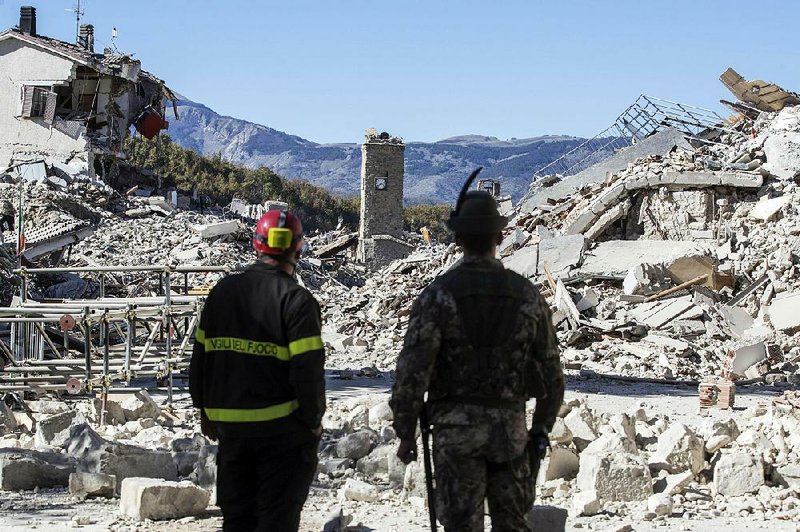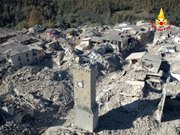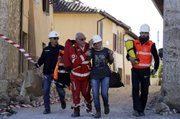ROME -- An earthquake, believed to be the strongest to hit Italy in almost 36 years, struck the center of the country on Sunday, sparing lives but destroying beloved landmarks, some of which dated to the Middle Ages.
Lost or severely damaged in the shaking were ancient Roman walls, Gothic and Baroque churches, and centuries-old paintings crushed beneath tons of brick, sandstone and marble.
Italian Premier Matteo Renzi said the nation's "soul is disturbed" by the series of quakes, starting with the deadly Aug. 24 earthquake that killed nearly 300 people, two back-to-back temblors on Wednesday, and the biggest of them all, the 6.6-magnitude quake that shook people out of bed Sunday morning.
Renzi vowed to rebuild houses, churches and businesses, saying, "a piece of Italian identity is at stake at this moment."
"Feeling the earth collapse beneath your feet is not a metaphorical expression but is what happened this morning," Renzi said. "Half of Italy felt this."
The Italian government allocated about $44 million to the stricken zones after Wednesday's quakes, and Renzi said Sunday that more would be set aside to deal with the fresh damage.
"We will broaden the crater zone so no town must fear it might be left out," he said.
Renzi called on citizens to be strong and show solidarity. "Italy has its limitations and defects, but in these circumstances it gives the best of itself," he said.
The quake was felt as far north as Salzburg, Austria, and all the way down the Italian peninsula to the Puglia region, the heel of the Italian "boot." In Rome, some 95 miles away from the epicenter, people rushed into the streets in pajamas.
There were reports of 20 people injured, but no reports of fatalities -- a fact attributed to the evacuation of sensitive areas and fragile city centers. Some 3,600 people had been moved to shelters, hotels and other temporary accommodations after last week's quakes. Many who stayed behind were sleeping in campers or other vehicles, out of harm's way.
Electrical power was out for many thousands of residences, and many roads were blocked by fallen masses or crevices. Fabrizio Curcio, the head of Italy's civil protection department, said several sections of the Salaria, the most important highway in the area, were not accessible.
"We can't assist people while they are still in the earthquake zone," Curcio said, explaining why residents of the stricken cities were being deployed to hotels on the coast and other areas. "We haven't had an earthquake of this magnitude since 1980, so there are a series of controls we have to carry out."
The 6.9-magnitude earthquake on Nov. 23, 1980, near Naples killed some 3,000 people.
Seismologists said the shaking Sunday came from a series of faults in the Apennines, and they could not rule out more, possibly stronger quakes in the near future.
"It is normal for the Apennines," said Carlo Doglioni, the president of Italy's National Institute for Geophysics and Vulcanology. He cited a similar sequence of three events within a period of months in 1703 in the region.
Natural law dictates that after such an event there will be more quakes, "which means we can expect some 5 magnitude quakes and many of magnitude 4," Doglioni said.
On Sunday the institute recorded more than 200 other seismic events, including 15 temblors between magnitude 4 and 5.
Churches Destroyed
Sunday's quake struck another blow to the rich artistic heritage of villages that dot the Apennine Mountains.
Norcia, a town in Umbria that considers itself the birthplace of pork sausage, was the closest to the epicenter and sustained the worst damage. Two churches were destroyed -- the 14th century Basilica of St. Benedict, built on the traditional birthplace of St. Benedict, founder of the Benedictine monastic order; and the Cathedral of St. Mary Argentea, known for its 15th century frescoes. Only the cracked facades were still standing, with most of the structures disintegrating into piles of rubble and dust.
Television images showed nuns rushing into the main piazza as the bell tower appeared on the verge of collapse. Later, nuns and monks knelt in prayer in the main piazza. A firefighter appealed to a priest to help keep residents calm to prevent them from looking for loved ones.
When the quake stuck, nuns from the Saint Mary of Peace monastery in Norcia were praying and singing hymns. The shaking caused their building to collapse and badly damaged their sleeping quarters. Later, firefighters escorted them back inside to retrieve holy books. Then an aftershock hit.
"But we had courage, because we were in our house and the Lord protects us," one nun told The Associated Press.
Large sections of Norcia's ancient Roman city walls -- which suffered damage and cracks in the previous quakes -- crumbled, as did towers.
Amatrice, the town that bore the brunt of destruction on Aug. 24, sustained blows to treasures that had withstood other quakes.
The community's medieval bell tower stood tall amid the rubble after the August quake, becoming a symbol of hope and resilience for the stricken population. During a visit to the quake zone earlier this month, the pope prayed alone in the rubble, the brick tower still standing in the background. But the latest shaking partially collapsed it. The 15th century Church of Sant'Agostino also fell down.
The basilica of St. Paul Outside the Walls, a site of Christian worship in Rome since the 4th century, had to be closed for inspections after sustaining cracks and damage to some molding. There were also cracks in the cupola of Sant'Ivo alla Sapienza church in Rome, a baroque masterpiece by Francesco Borromini, an architectural giant of the 17th century.
The quake forced the temporary closure of some of Rome's most important tourist sites, including the presidential palace, so authorities could check for damage.
The crowds in St. Peter's Square interrupted Pope Francis with applause when he mentioned the quake during his weekly Sunday blessing.
"I'm praying for the injured and the families who have suffered the most damage, as well as for rescue and first-aid workers," he said.
In Camerino, a hilltop town, city spokesman Emmanuele Pironi said most of the area's 9,000 university students had left after the historic center was closed several days ago, and some of the 7,000 residents had been moved to hotels near the coast or to shelters nearby. Few remained in their homes.
The mayor of Ussita said a huge cloud of smoke erupted from the crumbled buildings of his town Sunday morning.
"It's a disaster, a disaster," Mayor Marco Rinaldi said. "I was sleeping in the car and I saw hell."
Rinaldi said 90 percent of the houses in the town have crumbled.
The quake damaged the church of St. Joseph in Jesi, a town encircled by medieval walls southwest of the coastal city of Ancona. The roof caved in partially and cracks appeared near the altar.
In Tolentino, there was visible damage to the Cathedral of San Catervo and the Basilica of St. Nicolas, which contains artwork and architectural elements dating from the 14th to the 17th centuries.
Rebuilding the churches and other landmarks will be painstaking, but not impossible.
"In Italy we do not throw away the rubble," said Fabio Carapezza-Guttuso, the Ministry of Culture's national crisis management unit officer. "Even single stones are numbered and handpicked so that they can later be used in the reconstruction, along with pieces of wood, iron and beams. It's a big effort, and that is why we employ archaeologists to sift through the ruins."
Information for this article was contributed by Colleen Barry, Vanessa Gera and Gregorio Borgia of The Associated Press; by Stefano Pitrelli of The Washington Post; and by Elisabetta Povoledo of The New York Times.
A Section on 10/31/2016


